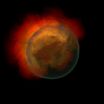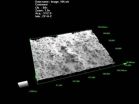(Press-News.org) DNA sequences obtained from a handful of patients with multiple sclerosis at the University of California, San Francisco (UCSF) Medical Center have revealed the existence of an "immune exchange" that allows the disease-causing cells to move in and out of the brain.
The cells in question, obtained from spinal fluid and blood samples, are called B cells, which normally help to clear foreign infections from the body but sometimes react strongly with the body itself. One of the current theories of multiple sclerosis, which strikes hundreds of thousands of Americans and millions more worldwide, holds that the disease manifests when self-reactive B cells in the brain become activated and cause inflammation there.
The apparent exchange of the cells between the brain and the blood may be a key to unlocking better treatments and diagnostics, because the activated B cells causing problems in the brain may be accessible when they move from the brain to the periphery.
"The hope is that if we can identify culprit B cells, using precise tools, we will be able to better diagnose multiple sclerosis and monitor disease activity. In addition, in ways that may have to be tailored for each patient, this may also allow us to develop therapies that directly target disease-causing B cells," said UCSF neurologist Hans Christian von Büdingen, MD, who led the research.
Described this week in the Journal of Clinical Investigation, the work is the latest from the UCSF Multiple Sclerosis Center, part of the UCSF Department of Neurology and one of the leading programs in multiple sclerosis research and patient care worldwide.
Since 2008, a UCSF team led by the chair of the Department of Neurology, Stephen Hauser, MD, has completed two clinical trials that showed, in essence, that blocking B cells may stop the attacks, or flare-ups, that occur in people with multiple sclerosis. These trials used Rituximab and Ocrelizumab, both of which target a molecule called CD20 found on the surface of B cells.
The new work suggests that targeting B cells could be extended into a precision strategy that would specifically tailor treatments to the exact identity of the B cells at work in any one patient.
Background on B cells and Multiple Sclerosis
Multiple sclerosis is a common, chronic disease affecting some 350,000 Americans whose immune systems periodically attack the myelin sheaths that insulates nerve fibers in the brains and spinal cord. Damage to the sheaths can short-circuit signals traveling along the nerve fibers, disrupting the normal flow of communication from the brain and causing a range of symptoms.
The disease is about three times more prevalent among women than men, and for reasons scientists do not understand, the number of women who have the disease has been increasing in proportion to men. Decades ago, there were about as many men as women with multiple sclerosis.
That disparity is not the only mystery surrounding multiple sclerosis. The severity of the disease can vary wildly, from people who have mild disease, rarely having symptoms, to people who suffer significant deficits for long periods of time, sometimes progressively, with weakness, sensory disturbance, fatigue, visual impairments and loss of coordination. In addition, scientists do not understand what triggers MS attacks, though researchers at UCSF and elsewhere are actively investigating a number of possible genetic and environmental triggers, including low vitamin D levels.
There also is a need to find better ways to diagnose, monitor and track the disease – a need that may be helped by the new discovery.
"We don't have any specific diagnostic tool at this point – no biomarker that we can look for to say, 'this is multiple sclerosis'," von Büdingen said.
INFORMATION:
The article, "B cell exchange across the blood-brain barrier in multiple sclerosis" by H.-Christian von Büdingen, Tracy C. Kuo, Marina Sirota, Christopher J. van Belle, Leonard Apeltsin, Jacob Glanville, Bruce A. Cree, Pierre-Antoine Gourraud, Amy Schwartzburg, Gabriella Huerta, Dilduz Telman, Purnima D. Sundar, Tyler Casey, David R. Cox and Stephen L. Hauser was published online by the Journal of Clinical Investigation on Nov.19, 2012. See: http://dx.doi.org/10.1172/JCI63842
In addition to UCSF, authors on this study were affiliated with Applied Quantitative Genotherapeutics and Protein Engineering, which are both divisions of Rinat-Pfizer Inc.
This work was supported by grants from Pfizer Inc., The Nancy Davis Foundation, and the National Institutes of Health through grant #R01NS026799, #R01NS049477, and #K02NS072288.
Additional supported was provided by an endowment from the Rachleff Family Foundation, a FCMSC Research Scholarship and a PACCTR Short-Term Fellowship from UCSF.
UCSF is a leading university dedicated to promoting health worldwide through advanced biomedical research, graduate-level education in the life sciences and health professions, and excellence in patient care.
Follow UCSF
UCSF.edu | Facebook.com/ucsf | Twitter.com/ucsf | YouTube.com/ucsf
Multiple sclerosis 'immune exchange' between brain and blood is uncovered
UCSF finding of movement with disease-causing B cells gives hope for new treatments and diagnostics
2012-11-20
ELSE PRESS RELEASES FROM THIS DATE:
Comments, traffic statistics help empower bloggers
2012-11-20
UNIVERSITY PARK, Pa. -- Whether bloggers are writing to change the world, or just discussing a bad break-up, they may get an extra boost of motivation from traffic-measuring and interactive tools that help them feel more connected to and more influential in their communities, according to researchers.
In a series of studies, female bloggers showed that they enjoyed blogging because it made them feel empowered and part of a community, said Carmen Stavrositu, who recently completed doctoral work in mass communications at Penn State. The studies also indicated that the sheer ...
Failed explosions explain most peculiar supernovae
2012-11-20
Supercomputer simulations have revealed that a type of oddly dim, exploding star is probably a class of duds—one that could nonetheless throw new light on the mysterious nature of dark energy.
Most of the thousands of exploding stars classified as type Ia supernovae look similar, which is why astrophysicists use them as accurate cosmic distance indicators. They have shown that the expansion of the universe is accelerating under the influence of an unknown force now called dark energy; yet approximately 20 type Ia supernovae look peculiar.
"They're all a little bit ...
Scripps Research Institute team identifies a potential cause of Parkinson's disease
2012-11-20
LA JOLLA, CA – November 19, 2012 – Deciphering what causes the brain cell degeneration of Parkinson's disease has remained a perplexing challenge for scientists. But a team led by scientists from The Scripps Research Institute (TSRI) has pinpointed a key factor controlling damage to brain cells in a mouse model of Parkinson's disease. The discovery could lead to new targets for Parkinson's that may be useful in preventing the actual condition.
The team, led by TSRI neuroscientist Bruno Conti, describes the work in a paper published online ahead of print on November 19, ...
Astronomers pin down origins of 'mile markers' for expansion of universe
2012-11-20
COLUMBUS, Ohio – A study using a unique new instrument on the world's largest optical telescope has revealed the likely origins of especially bright supernovae that astronomers use as easy-to-spot "mile markers" to measure the expansion and acceleration of the universe.
In a paper to appear in the Astrophysical Journal, researchers describe observations of recent supernova 2011fe that they captured with the Large Binocular Telescope (LBT) using a tool created at Ohio State University: the Multi-Object Double Spectrograph (MODS).
MODS measures the frequencies and intensities ...
Smoking in pregnancy tied to lower reading scores
2012-11-20
Yale School of Medicine researchers have found that children born to mothers who smoked more than one pack per day during pregnancy struggled on tests designed to measure how accurately a child reads aloud and comprehends what they read.
The findings are published in the current issue of The Journal of Pediatrics.
Lead author Jeffrey Gruen, M.D., professor of pediatrics and genetics at Yale School of Medicine, and colleagues analyzed data from more than 5,000 children involved in the Avon Longitudinal Study of Parents and Children (ALSPAC), a large-scale study of ...
Astronomers directly image massive star's 'super-Jupiter'
2012-11-20
Astronomers using infrared data from the Subaru Telescope in Hawaii have discovered a "super-Jupiter" around the bright star Kappa Andromedae, which now holds the record for the most massive star known to host a directly imaged planet or lightweight brown dwarf companion.
Designated Kappa Andromedae b (Kappa And b, for short), the new object has a mass about 12.8 times greater than Jupiter's. This places it teetering on the dividing line that separates the most massive planets from the lowest-mass brown dwarfs. That ambiguity is one of the object's charms, say researchers, ...
Ah, that new car smell: NASA technology protects spacecraft from outgassed molecular contaminants
2012-11-20
Outgassing — the physical process that creates that oh-so-alluring new car smell — isn't healthy for humans and, as it turns out, not particularly wholesome for sensitive satellite instruments, either. But a team of NASA engineers has created a new way to protect those instruments from its ill effects.
For some people, the best part about buying a new car is its factory-fresh new car smell, a distinctive aroma created when the chemicals and residual solvents used to manufacture dashboards, car seats, carpeting and other vehicle appointments outgas and fill the cabin. ...
Some cells don't know when to stop
2012-11-20
Certain mutated cells keep trying to replicate their DNA — with disastrous results — even after medications rob them of the raw materials to do so, according to new research from USC.
New imaging techniques allowed scientists to see for the first time that while chemotherapy drugs shut down the DNA replication process of most cancer cells, so-called "checkpoint mutants" just keep chugging along, unwinding the DNA and creating damaged DNA strands that can result in the kind of abnormalities seen in cancer cells.
"Older methods suggested that these checkpoint mutants ...
NASA sees sun's 2 Prominence Eruptions
2012-11-20
VIDEO:
The Sun erupted with two prominence eruptions, one after the other over a four-hour period (Nov. 16, 2012). The action was captured in the 304 Angstrom wavelength of extreme ultraviolet...
Click here for more information.
The Sun erupted with two prominence eruptions, one after the other over a four-hour period on Nov. 16, 2012, between the hours of 1 and 5 a.m. EST. The red-glowing looped material is plasma, a hot gas made of electrically charged hydrogen and helium. ...
Beargrass, a plant of many roles, is focus of new report
2012-11-20
Beargrass is an ecologically, culturally, and economically important plant in the Western United States and, for the first time, landowners, managers, and harvesters now have a comprehensive report about the species.
The report, Natural and Cultural History of Beargrass (Xerophyllum tenax), published by the U.S. Forest Service's Pacific Northwest Research Station, identifies critical knowledge gaps and areas for future research. It also documents how changes in disturbance, including fire, may affect the species across its range.
"Beargrass is emblematic of a web of ...
LAST 30 PRESS RELEASES:
KIST develops eco-friendly palladium recovery technology to safeguard resource security
Statins significantly reduce mortality risk for adults with diabetes, regardless of cardiovascular risk
Brain immune cells may drive more damage in females than males with Alzheimer’s
Evidence-based recommendations empower clinicians to manage epilepsy in pregnancy
Fungus turns bark beetles’ defenses against them
There are new antivirals being tested for herpesviruses. Scientists now know how they work
CDI scientist, colleagues author review of global burden of fungus Candida auris
How does stroke influence speech comprehension?
B cells transiently unlock their plasticity, risking lymphoma development
Advanced AI dodel predicts spoken language outcomes in deaf children after cochlear implants
Multimodal imaging-based cerebral blood flow prediction model development in simulated microgravity
Accelerated streaming subgraph matching framework is faster, more robust, and scalable
Gestational diabetes rose every year in the US since 2016
OHSU researchers find breast cancer drug boosts leukemia treatment
Fear and medical misinformation regarding risk of progression or recurrence among patients with breast cancer
Glucagonlike peptide-1 receptor agonists and asthma risk in adolescents with obesity
Reviving dormant immunity: Millimeter waves reprogram the immunosuppressive microenvironment to potentiate immunotherapy without obvious side effects
Safety decision-making for autonomous vehicles integrating passenger physiological states by fNIRS
Fires could emit more air pollution than previously estimated
A new way to map how cells choose their fate
Numbers in our sights affect how we perceive space
SIMJ announces global collaborative book project in commemoration of its 75th anniversary
Air pollution exposure and birth weight
Obstructive sleep apnea risk and mental health conditions among older adults
How talking slows eye movements behind the wheel
The Ceramic Society of Japan’s Oxoate Ceramics Research Association launches new international book project
Heart-brain connection: international study reveals the role of the vagus nerve in keeping the heart young
Researchers identify Rb1 as a predictive biomarker for a new therapeutic strategy in some breast cancers
Survey reveals ethical gaps slowing AI adoption in pediatric surgery
Stimulant ADHD medications work differently than thought
[Press-News.org] Multiple sclerosis 'immune exchange' between brain and blood is uncoveredUCSF finding of movement with disease-causing B cells gives hope for new treatments and diagnostics




